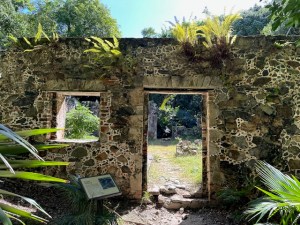Cinnamon Bay Sugar Mill: Echoes of History in St. John’s Timeless Ruins
Historical Background
The history of the Cinnamon Bay Sugar Mill dates back to the 18th century when the island was a hub for sugar cultivation and processing. The mill, along with the adjacent plantation, played a crucial role in the economy of the region during the era of European colonization. The remnants of the sugar mill serve as a tangible link to this bygone era, allowing visitors to connect with the island’s past.

Informational signs around the sugar factory ruins
Plantation Life
In its heyday, the Cinnamon Bay Sugar Mill was part of a larger plantation that likely encompassed vast acres of land. The plantation system was characterized by the cultivation of sugar cane, a labor-intensive crop that required significant manpower. Enslaved Africans and later, indentured laborers, toiled in the fields, harvesting and processing the sugar cane that would eventually find its way to the mill.
Visitors to the site can explore the ruins of the plantation, gaining insight into the daily lives of those who lived and worked here. The remnants of slave quarters, windmills, and other structures provide a poignant reminder of the island’s complex history.
Architecture and Engineering
The architecture of the Cinnamon Bay Sugar Mill reflects the technology and engineering of its time. The main structure of the mill includes a circular mill wall with openings for the massive vertical rollers that crushed the sugar cane to extract its juice. The juice was then boiled down to produce sugar and molasses. The engineering ingenuity of the mill’s design is evident, showcasing the innovative methods employed in the processing of sugar during the 18th century.
As visitors explore the ruins, they can marvel at the remnants of the machinery that once powered the mill. The sheer scale of the equipment highlights the magnitude of the industry that once thrived on the island.
Preservation Efforts
The Cinnamon Bay Sugar Mill and its surrounding structures have undergone extensive preservation efforts to ensure that future generations can appreciate and learn from this historical site. The National Park Service, in collaboration with local and international organizations, has worked diligently to stabilize and protect the ruins from the natural elements and the passage of time.
Interpretive signs and guided tours are available to enhance the visitor experience, providing historical context and insights into the significance of the Cinnamon Bay Sugar Mill within the broader context of the island’s history.
Cultural Significance
Beyond its historical and architectural importance, the Cinnamon Bay Sugar Mill holds cultural significance for the people of St. John and the U.S. Virgin Islands. It serves as a symbol of resilience, reflecting the island’s ability to adapt and evolve over the centuries. The stories of the individuals who lived and worked on the plantation, often under challenging conditions, are an integral part of the island’s cultural narrative.
Visitors to the sugar mill can immerse themselves in the rich tapestry of St. John’s history, gaining a deeper appreciation for the cultural influences that have shaped the island. Local traditions, music, and cuisine bear the marks of the diverse heritage that stems from the interactions between African, European, and Caribbean cultures.
Ecotourism and Natural Beauty
In addition to its historical and cultural significance, the Cinnamon Bay Sugar Mill is situated within the stunning landscapes of the Virgin Islands National Park. The surrounding area is a haven for ecotourism, offering visitors the opportunity to explore pristine beaches, lush tropical forests, and vibrant coral reefs.
Hiking trails meander through the park, providing access to breathtaking viewpoints and hidden gems. The juxtaposition of the historic sugar mill ruins against the backdrop of the natural beauty of St. John creates a unique and captivating experience for those who venture to this corner of the island.

The main entrance to the sugar factory
Conclusion
The Cinnamon Bay Sugar Mill stands as a captivating testament to St. John’s past, weaving together threads of history, culture, and natural beauty. As visitors explore the ruins, they are transported back in time to an era when sugar production was a driving force in shaping the island’s identity. The preservation of this historical site not only honors the resilience of the people who lived and worked here but also provides a platform for education and reflection.
In the heart of the Virgin Islands National Park, the Cinnamon Bay Sugar Mill invites visitors to appreciate the interconnectedness of history and nature. It serves as a bridge between the past and the present, inviting exploration, contemplation, and a deeper understanding of the rich tapestry that is St. John’s cultural and historical heritage.
